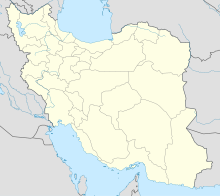Hajji Firuz Tepe
Coordinates: 36 ° 59 ′ 40 ″ N , 45 ° 28 ′ 28 ″ E
Hajji Firuz Tepe is an archaeological site in the Iranian province of West Azerbaijan in the west of the country. Archaeologists from the University of Pennsylvania Museum of Archeology and Anthropology carried out excavations at the site between 1958 and 1968 . A village from the Neolithic Age came to light , which was built in the second half of the 6th millennium BC. Was inhabited and shows some of the oldest signs of wine production .
Location and surroundings
Hadschi Firuz Tepe is located in the Gadar river valley south of Lake Urmi in the Sulduz plain. Nearby is the modern village of Hadschi Firuz (cf. Hadschi Firuz ). It is a 140 by 200 meter oval settlement hill ( Tell ) and rises 10.3 meters above the plain. There are also finds below the level. The plain is part of the north-western Zāgros Mountains and is 1300-1350 m above sea level. The Gadar flows here in an easterly direction and flows into Lake Urmia. The plain is an important traffic junction from where routes lead in all directions. So you can get here over the Kel-i-Schin -Pass through the Zāgros Mountains to Rawanduz and from there on into the Mesopotamian plain. The wild form of the grapevine ( Vitis vinifera subsp. Sylvestris ) grew and continues to grow in the vicinity of Hajji Firuz Tepes .
Research history
Hajji Firuz Tepe was first noticed in 1936 by Sir Aurel Stein , who made some pottery shards on the surface. Between 1958 and 1968 four excavation campaigns were carried out as part of the Hasanlu excavations. Hasanlu, which is only two kilometers away, is another important site and is home to an ancient city. As part of the excavations there, the surroundings were also examined. The heads of the excavations were Charles Burney (1958, 1961), T. Cuyler Young Jr. (1961), who also explored Dalmā Tepe at the same time , and Robert H. Dyson and Mary M. Voigt (1968). For each excavation campaign, a square shaft was driven into the hill.
colonization

Although the excavations focused on the Neolithic phase, traces of later settlement were also found. Finds from the Copper Age , the Late Bronze Age , the Iron Age and from the 11th century AD were made in different layers . Even so, the Neolithic period was the most important phase of Hajji Firuz Tepe. It can be divided into twelve sections, where A stands for the oldest and L for the youngest phase.
wine growing
The signs of wine production in Hajji Firuz Tepe are six buried jugs with a volume of nine liters. These were in a mud house that was built between 5400 and 5000 BC. Was inhabited, found. Yellowish residues containing traces of tartaric acid and calcium tartrate were discovered inside the jugs . In addition, the resin of the turpentine pistachio was found, which, similar to the Greek retsina wine , could have served as a preservative.
Consequences of the discovery
While the jugs are not definitive proof, they make the winemaking very likely. Tartaric acid occurs naturally in non-fermented grapes, but its high proportion in wine crystallizes and is deposited in wine containers. Grapes also have a tendency to ferment into alcohol through natural fermentation. This already happens in closed containers at room temperature. Therefore, the buried jars could have been mere grape containers that allowed natural fermentation.
However, the presence of rosin suggests that fermentation was intended. Resin was used for sealing and preserving a long time before the Greeks added it to their wine. In addition, the volume of all the jugs (54 liters) indicates that wine was probably produced here beyond personal use. Archaeologists also found matching clay stoppers near the jugs - another indication that the juice was stored here for a longer period of time and protected from air.
Other finds
The zāgros, which separates the states of Armenia, Turkey and Iraq from Iran, is the range of many wild species of the grapevine. The separate-sex plant offered the ancient inhabitants the opportunity to get grapes. Several other sites from the area around the Zāgros show finds similar to those of Hajji Firuz Tepe. Further south, in Godin Tepe , the 3500-3000 BC. Was inhabited, buried jugs with a capacity of 30 or even 60 liters were found. Both these jugs and basins, which were probably used to press the grapes, showed traces of wine residues.
literature
- Mark Berkowitz: World's Earliest Wine . In: Archeology . tape 49 , no. 5 , 1996 ( online [accessed December 13, 2010]).
- G. Harding: A Wine Miscellany . Clarkson Potter, New York 2005, ISBN 0-307-34635-8 .
- Patrick E. McGovern, Donald L. Glusker, Lawrence J. Exner, Mary M. Voigt: Neolithic resinated wine . In: Nature . tape 381 , no. 6582 , 1996, pp. 480-481 , doi : 10.1038 / 381480a0 .
- T. Pellechia: Wine. The 8,000-Year-Old Story of the Wine Trade . Running Press, London 2006, ISBN 1-56025-871-3 .
- R. Phillips: A Short History of Wine . Ecco, New York 2000, ISBN 0-06-621282-0 .
- Mary M. Voigt: Hajji Firuz Tepe, Iran. The Neolithic settlement (= University Museum Monograph . Volume 50 ). University Museum, Philadelphia 1983, ISBN 0-934718-49-0 ( limited in Google book search).
Web links
- University of Pennsylvania The Origins and Ancient History of Wine - With pictures from the Hajji Firuz Tepe excavation
